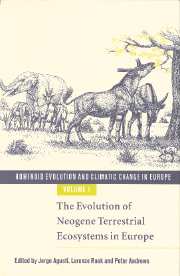Book contents
- Frontmatter
- Contents
- List of contributors
- Acknowledgements: The European Science Foundation
- 1 Introduction
- PART I Palaeogeography of the circum-Mediterranean region
- PART II Miocene mammalian successions
- PART III Palaeoenvironments: non-mammalian evidence
- 14 Marine invertebrate (chiefly foraminiferal) evidence for the palaeogeography of the Oligocene–Miocene of western Eurasia, and consequences for terrestrial vertebrate migration
- 15 Palaeoclimatic implications of the energy hypothesis from Neogene corals of the Mediterranean region
- 16 Contribution to the knowledge of Neogene climatic changes in western and central Europe by means of non-marine molluscs
- 17 Sedimentary facies analysis in palaeoclimatic reconstructions. Examples from the Upper Miocene–Pliocene successions of south-central Tuscany (Italy)
- 18 Neogene vegetation changes in West European and West circum-Mediterranean areas
- PART IV Palaeoenvironments: mammalian evidence
- Index
17 - Sedimentary facies analysis in palaeoclimatic reconstructions. Examples from the Upper Miocene–Pliocene successions of south-central Tuscany (Italy)
from PART III - Palaeoenvironments: non-mammalian evidence
Published online by Cambridge University Press: 15 December 2009
- Frontmatter
- Contents
- List of contributors
- Acknowledgements: The European Science Foundation
- 1 Introduction
- PART I Palaeogeography of the circum-Mediterranean region
- PART II Miocene mammalian successions
- PART III Palaeoenvironments: non-mammalian evidence
- 14 Marine invertebrate (chiefly foraminiferal) evidence for the palaeogeography of the Oligocene–Miocene of western Eurasia, and consequences for terrestrial vertebrate migration
- 15 Palaeoclimatic implications of the energy hypothesis from Neogene corals of the Mediterranean region
- 16 Contribution to the knowledge of Neogene climatic changes in western and central Europe by means of non-marine molluscs
- 17 Sedimentary facies analysis in palaeoclimatic reconstructions. Examples from the Upper Miocene–Pliocene successions of south-central Tuscany (Italy)
- 18 Neogene vegetation changes in West European and West circum-Mediterranean areas
- PART IV Palaeoenvironments: mammalian evidence
- Index
Summary
Introduction
One of the purposes of the workshop on ‘Climatic and environmental changes in the Neogene of Europe’, was to assemble different points of view on problems which by their nature need a multidisciplinary approach. Climatic and environmental changes can be detected in the geologic record by palaeontologists, sedimentologists and geochemists, through integration of their efforts. The goal of this paper is to show how sedimentology can contribute to such multidisciplinary studies. Facies analysis has acquired a great importance in the detailed study of sedimentary deposits. A facies is a rock or sediment unit distinguishable from others on the basis of its specific aspect (from Latin facies) including lithologic, sedimentologic, and biologic features. A sedimentary facies records the physical, chemical or biological processes operating during sedimentation. Facies associations and sequences (the spatial arrangement of facies) provide information on the depositional environments and on their dynamics. Selected examples from Upper Miocene–Pliocene continental and shallow marine deposits filling some post-collisional basins in southern and central Tuscany (central Italy, Fig. 17.1a), will show in the following paragraphs, the potentialities and limits of facies analysis as an integrative tool for palaeoclimatic reconstructions.
General setting
The sedimentary basins we deal with in this paper are located in central and southern Tuscany (central Italy), on the western margin of the Northern Apennines, a thrust and fold chain whose formation started in the Late Cretaceous. In the Middle (Carmignani et al., 1994) or Late Miocene the western side of the chain was affected by crustal extension, possibly alternated with (Bernini et al. (1990) or subordined to (Boccaletti et al., 1991, 1995) compression.
- Type
- Chapter
- Information
- Hominoid Evolution and Climatic Change in Europe , pp. 355 - 377Publisher: Cambridge University PressPrint publication year: 1999
- 3
- Cited by

